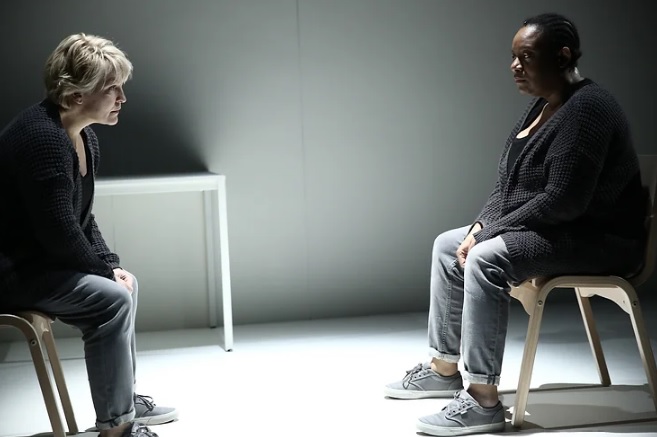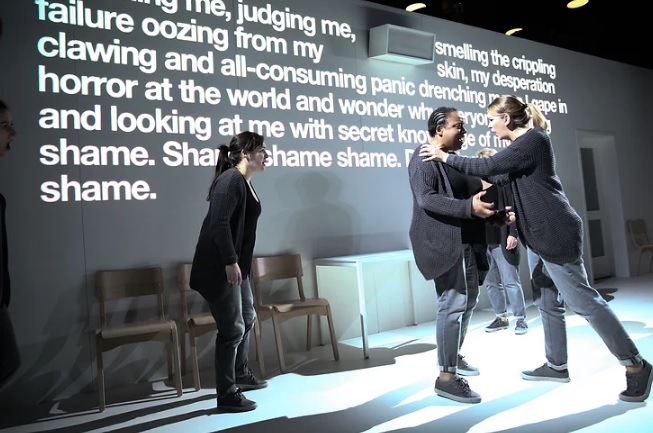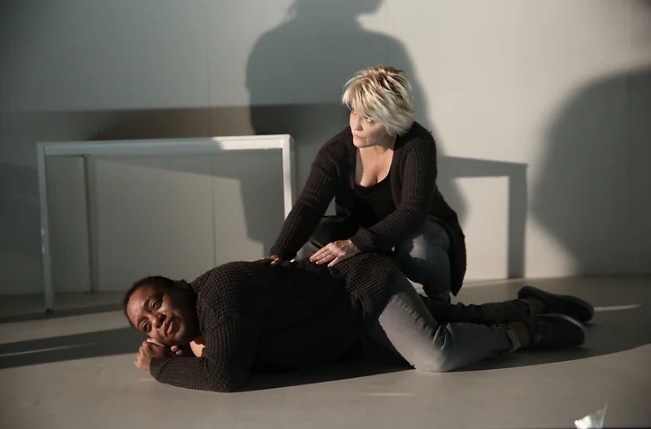4.48 Psychosis (Prototype, NY)
4:48 Psychosis US premiere in New York
Play 4:48 Psychosis was the last work of playwright Sarah Kane. Since 2000 when the play was first premiered there was numerous theatre productions presented. Surprisingly, first musical version of the works was presented only on 2016, to Lyric Hammersmith viewers. First presented to British audience the work reached international acclaim and was presented at this year‘s contemporary opera and music-theatre festival Prototype in New York (held annually, on January).
The play is a documentation of an inner dialogue while trying to survive having depression. It contains strong language, at times has interesting fluid structure, where the line lining is flowing like a river to the right and comes back to far left side, or the lines being tossed around in the page. There are no strict rules, regulations, fixed characters in the play, so the director of stage production can improvise quite free-handedly. The text distinguished at least two characters – doctor and the patient, although in every production the solution of depicting the characters are different.
In the version, recently presented to New York operagoers in Prototype festival, viewers face with six main characters. One is opposing to all others and this character (played by Gweneth-Ann Rand) looks like the main, common sense like, the “I” of the character who is suffering from severe depression. All other five women depicts inner voice or different parts of the character (played by Lucy Hall, Susanna Hurrell, Samantha Price, Rachael Lloyd, Lucy Schaufer). All of the soloists are singing in wide range while creating calm, soothing atmosphere at times, then again, when the situation and mood of the scene changes – soloists are singing in small seconds or other concord which brings shivers and sense of horror. The singers also are acting, most of the time using minimal movements, dragging feet as tired of life people do, leaning on walls when the body is no longer capable to hold on the weight of the heavy thoughts. In contrast, there are moments of anger breakthrough, pulling, bullying, and pushing the main character – scenes that are much more energetic and dynamic. During those episodes not the physical violence effects the most, but understanding, that one self’s thoughts are belittling, hurting, damaging, and there is no one who could stop this violence. Singing is more convincing than acting in this staging. Music plants the feeling of the cruelty of the mind when it is attacking. Graveness of depression and the terror that a person is experiencing while having this illness could be felt inside veins thanks to emotionally engaging music.




Orchestra, containing woodwinds, piano, synthesizer, strings, accordion and a wide range of percussion, made the palette of sounds indeed colorful. Interesting instrument combinations, like accordion and synthesizer playing organ sounds to get horrifying notes, or glissandos and chord clusters played by all the instruments depicting the state of mind in which the main character is. All of those musical choices gave unexpectedly accurate color of mood. Although, in tragical production percussion gave a spark of humor. The doctor has some lines to say in the play. He only illuminates the loneliness of the main character by not understanding or not even trying to do so. Not understanding what she is going through the whole time. It might be said, that the doctor depicts carelessness, alienation between humans. As no actor is playing the character, percussion does. At start timpani, later hammered to metal pillar, play the words and syllables of the doctor part of the dialogue. On the final part of his words, the doctor is illustrated by jig sawing a wooden board and playing question mark with reception bell. In the beginning of the conversation main character does not say a word. Later, she also responds illustrated by other timpani in front of the first one. The last dialogue also is different from her side, because one of the singers is singing only first and last syllables of words. Her singing is tonal but not much verbal.
Besides the musical part of the dialogues, it is important to note, that text of both interlocutors was projected on the back wall of minimalistic stage. Video projections contained mostly of words and numbers and was used as complementary tool. Although, together with light and stage design all visuals helped in creating integral impacting result. Lights (designed by D. M. Wood) sharpened mood in scenes so professionally, that on intense episodes it seemed that singers are standing on the edge of a cliff, in contrast, at moments close to darkening of the consciousness, the light was blunt to emphasize the situation. All the light design worked hand in hand with stage design (created by Hannah Clark). Three stage doors are connected with light – as they opens the light comes into the stage together with singers. At first, the stage looks like a waiting room in a hospital since the light is pale white and direct. When the mood of the stage changes, we see a different angle of light and changing of shadow stretch. This emphasizes the whole episode and sharpens different parts of stage.
Tree white walls does not imply much emotional value by themselves, but in context with other stage elements, they maximize or minimize the effect on each viewer. One by one all the elements of this performance would not make such big impression of the agony a person is going through having clinical depression (and the singers are giving their best to stay stable while playing unstable character, which is emotionally extremely hard). In this production, all the elements played hand in hand and musicians, conducted by William Cole, together with director, who created the whole synthesized work, created emotional tsunami which crushed onto the audience and left us speechless.


